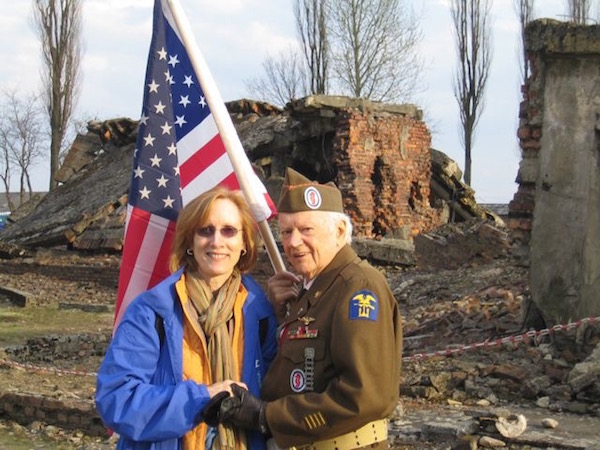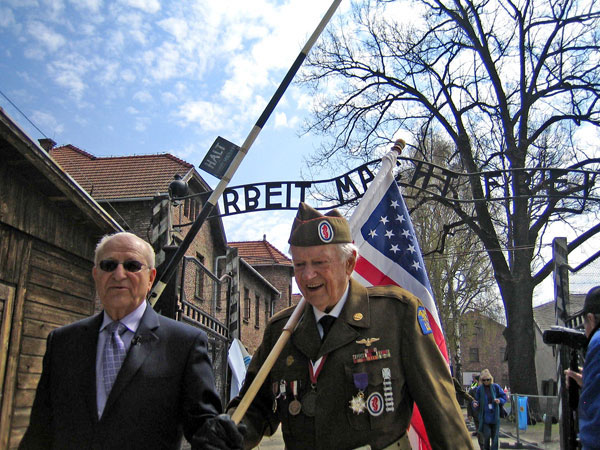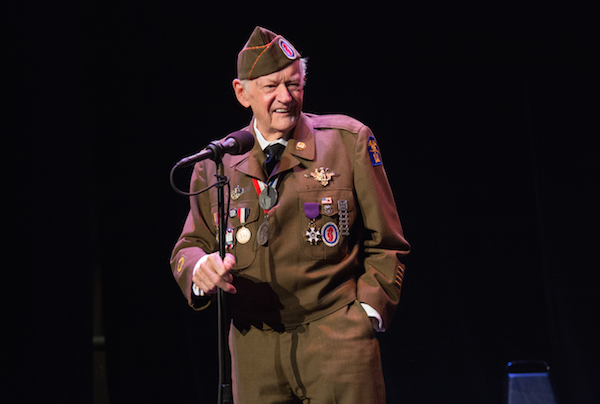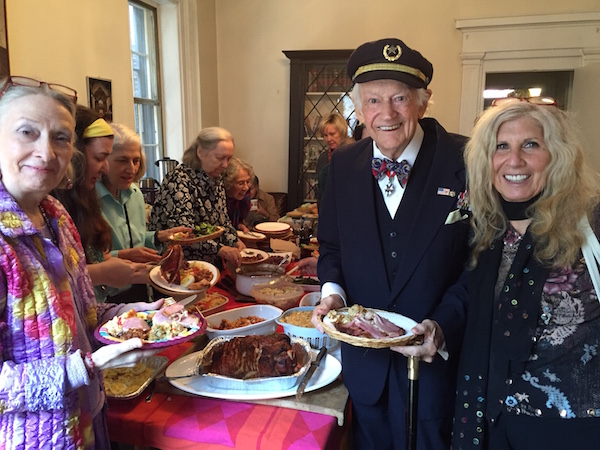
BY SCOTT STIFFLER | Walter Mitty himself could scarcely imagine the horrors, heroics, adventures, and achievements experienced by Frederick Goss Carrier — but unlike the daydreaming wannabe in James Thurber’s 1939 short story, Carrier’s fantastic tales of blazing through life as a 20th-century solider, artist, author, inventor, independent filmmaker and wildlife conservationist are the very real stuff of public record.
Carrier, known to all as “Rick,” passed away peacefully at his home in Chelsea on Dec. 12, 2016, at the age of 91. He was born in Etna, PA on Apr. 10, 1925 and grew up in nearby Pittsburgh during the Great Depression.
On New Year’s Eve 1943, he found himself sailing through the U-boat-infested North Atlantic Ocean on the Aquitania — a British ocean liner that, like the 18-year-old Carrier, had been drafted into military service. Once in England, Carrier’s boyhood knowledge of demolition work and subsequent US Army training in amphibious warfare earned him the rank of Specialist (T/5) Corporal working with mines, booby traps, and explosives. As part of the First Army, Seventh Corps, First Engineer Special Brigade, Carrier was among the first wave of D-Day troops to hit the Utah Beach in Normandy, France on June 6, 1944. Carrier would go on to march through France, Belgium and Germany as a front line participant in several other major European battles, including the Battle of the Bulge and Battle of Remagen.
On his 20th birthday, while behind enemy lines on a solo scouting mission to obtain strategic supplies, Carrier became the first allied soldier to discover Buchenwald concentration camp. The very next day, Apr. 11, 1945, he marched into the camp alongside Patton’s Third Army. Irving Roth, who was among the thousands of Buchwald prisoners to be liberated, met Carrier 67 years later at 2012’s March of The Living, an annual walk down the 3-kilometer path from Auschwitz to Birkenau. Roth, who currently serves as director of the Long Island, NY-based Holocaust Resource Center of Temple Judea of Manhasset, greeted Carrier with the words, “You saved my life.”

In June of 2014, Carrier returned to Normandy for a ceremony marking the 70th anniversary of D-Day. Four months later, the President of France awarded him the insignia of Chevalier [Knight] of the Legion of Honour — France’s highest honor.
By this time, Carrier had begun to speak publicly about his wartime experiences. In 2014, he participated in a World War II-themed installment of The Moth, a live storytelling session of true recollections, told without notes by authentic voices.
George Dawes Green, founder of The Moth, was concerned that the advanced age of the participants might make for less-than-riveting accounts. Then Carrier started speaking. “I had never seen so much energy come out of a human being,” Green noted. “Here’s a man who has stormed the beaches of Normandy; and yet, the story he told was really about a man who lived every moment of his life as a kind of adventure.”
Carrier’s ability to tell a ripping yarn with equal reverence for the adrenaline rush he experienced and the horrors he witnessed produced, for The Moth audience, “an almost hallucinatory” experience, Green recalled. “His vivid description of that terrible, fearsome day was harrowing, but also hilarious. He’s remembering the battle and these funny moments mixed in with all the gore and the horror and the fear…we were enrapt.”
As impressive as Carrier was in storytelling mode, Green also noted that this was a man who was equally engaged with the present. “What surprised me,” Green recalled, “was that afterwards, when we were talking, he was asking questions about what I was doing — and that’s a rare quality in someone who has lived so much, to be still completely curious about the people and the world around him.”
In addition to The Moth, Carrier spoke to church and civic groups, then translated some of the most dynamic moments from his live storytelling sessions onto printed page, in a breathtakingly paced three-part series published by Chelsea Now — work that would earn him an Honorable Mention in the Best Column category of 2015’s New York Press Association Better Newspaper Contest. “Rick’s columns seem movie-worthy and make for a great read,” wrote the judge. “His voice is one of only a few left, and to have him as a resource is invaluable.”

Carrier’s life from the mid-1940s onward was every bit as varied and distinguished as his period of military service. After World War II, he studied at the École des Beaux-Arts in Paris. Returning to America, he continued his education at the Tyler School of Art at Temple University in Philadelphia. He moved to Greenwich Village in 1953, living with his wife, Barbara, and their son, Marc. When Carrier’s marriage dissolved in the late 1960s, he met Lynn Ramsey, who would become his partner for the rest of his life.
Carrier’s US Army training in amphibious warfare led to civilian employment. He co-authored (with wife Barbara) 1955’s “Dive: The Complete Book of Skin Diving,” which piqued the interest of Howard Hughes. Summoned to a meeting with the tycoon, he parlayed their brief conversation into a job assignment: Invent a rigging system that allows movies to be enjoyed by an underwater audience. Carrier’s successful follow-through became the basis for a publicity stunt promoting a Hughes-produced Jane Russell vehicle, and ended up garnering more critical raves than the actual film, 1955’s “Underwater!”
After this success, Carrier was hired to do New York City-based publicity work for RKO Pictures. Further immersing himself in the world of filmmaking, he prepared to create a work of his own. By 1962, he had written, produced, directed, and edited “Strangers in the City,” a black and white feature about the struggles of a family in Spanish Harlem. When Turner Classic Movies screened the film, an introduction by Robert Osborne praised this “little-known independent film” for its contrast to “West Side Story” — which, Osborne noted, “had come out a year earlier, but the two pictures couldn’t be more different.” “Strangers,” asserted the host, “paints a much grittier, more realistic picture of lives of Puerto Rican immigrants than does that brightly-colored musical about Jets and Sharks and Tony and Maria.” Noting that Carrier also wrote the theme song for the film, Osborne concluded by declaring it to be “an interesting time capsule; a most interesting movie.”
This capacity to immerse himself in every aspect of any given endeavor was fondly recalled by William Daniel Grey, a professional musician and Broadway performer who met Carrier in the early 1970s through a mutual friend, filmmaker Larry Lindberg. Carrier — who would occasionally hang out on the set of a film Grey and Lindberg were making (1972’s “Tomorrow Morning”) — struck Grey as “the craziest person I ever met in my life, and take that in a good way. His mind just worked differently than most people’s. He would explore these fantastical realms,” recalled Grey, citing how Carrier generated ideas for everything from decreasing our dependency on fossil fuels to an epic opera written in collaboration with Grey, focusing on how immigrants came to influence various forms of American music. “Rick always started things, some of which he never finished,” Grey said, “which is a shame.”
Nonetheless, dozens of creative projects were fully realized by the determined Carrier. As an author, in addition to “Dive,” he would publish three more how-to books, all of them based on first-hand knowledge and told with gusto: 1972’s “Action! Camera! Super 8 Cassette Film Making for Beginners,” 1974’s “FLY: The Complete Book of Sky Sailing,” and 1985’s “ULTRALIGHTS: The Complete Book of Flying, Training and Safety.”
One time, having found himself in a songwriting phase, “Rick somehow hooked up with a string quartet,” Grey recalled, “so he said to me, ‘Do you think you can write a song and the quartet can play it at the ceremony?’ I took his lyrics and I wrote an anthem.” That anthem, “Across The American Sky,” was written to help promote The USA Bald Eagle Command, a nonprofit founded by Carrier in 1975 to protect the endangered American Bald Eagle. The organization’s efforts played a role in President Ronald Reagan’s declaration of June 20, 1982 as National Bald Eagle Day.
Allan Sanford, a supervisor in the Art Department at Morgan Stanley’s Manhattan offices, first met Carrier in 1987, when he was “one of the outside graphic art people brought in to help us when things were hectic.” Carrier’s ability to produce slides, brochures, and “any kind of sales material that the various offices around the world asked us for made him extremely valuable to us. This was pre-computer [graphics], and Rick would do everything: designing, setting the type, physically pasting it together.”

A lasting friendship soon developed between Sanford, his wife Shannon, and Carrier and life partner Lynn Ramsey — although only recently did he became aware of Carrier’s role in Word War II. “It was around four years ago that he started talking about it,” said Sanford of what happened at Normandy and Buchenwald. “Before that, it was always just, ‘Well, yeah, I was in an engineering battalion.’ ” Grey had similar recollections: “Up until about 10 years before he died, I never knew he was in the Second World War. Nobody ever had any idea that’s the kind of person he was before we knew him.”
Tracing his newfound willingness to speak about the war back to their 2012 trip to Poland, Ramsey noted the emotional impact that meeting other concentration camp liberators had on Carrier. Prior to that, she said, “he was interviewed a few times about the war, typically around Veterans Day, but he never mentioned Buchenwald.” Ramsey also noted that in his later years, Carrier found comfort — and a creative spark — in his deepening faith. Although the couple had been participating in the Chelsea Community Church Candlelight Carol Service every December since 1975, “We didn’t go to church regularly” until shortly after the 1994 death of Carrier’s son, Marc.
Not content to sit in the pews (or anywhere, for that matter), Carrier volunteered to mount a production based, in part, on the music of “Jesus Christ Superstar.” Grey (William Daniel, aka “Billy”), who played Jesus in the original Broadway production of “Superstar,” acted in, and supervised the music for, Carrier’s “Walk the Via Dolorosa” — which, Ramey recalled with pride, “ran every Palm Sunday from 1996 through 2006. It was very professional and very moving. People cried.”
In addition to Ramsey, Carrier is survived by his son, Alan Carrier, and two grandchildren, Camille Gibbons and Helen Carrier, of Cape Cod.
The congregation of Chelsea Community Church invites the public to celebrate the life of Rick Carrier on Sun., Jan. 1, as part of their weekly gathering (noon, at St. Peter’s Chelsea Episcopal Church: 346 W. 20th St., btw. Eighth & Ninth Aves.).


































